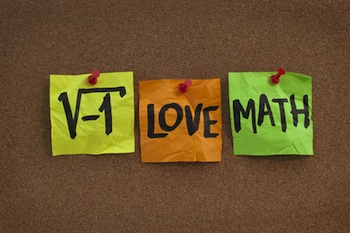Can a math vocabulary word wall really help students develop deeper meaning in mathematics? Absolutely, but only if you use it as one of your regular activities for teaching vocabulary.
A word wall can be one of the most useful activities for teaching academic content words.
Without a working knowledge of core math vocabulary, we actually put students at risk for failing.
These types of words are either Tier 2 or Tier 3 vocabulary and they should be embedded into the curriculum. A lot of Tier 2 ones even have different meanings in mathematics from everyday situations, which makes it especially difficult for our ESOL students.
What Should Be on a Math Word Wall?
Any academic content word can be displayed as concept maps, root words, and related words. English language learners and low SES students must have a contextual input on the word wall.
Also, students own representations (either by drawing or diagrams) of math vocabulary words should be included.
Some other key features of a working Math Vocabulary Word Wall are:
- Key words are highlighted for students to learn
- Words are organized (related to units or alphabetically)
- Students use the vocabulary during writing and as a resource for spelling
- Students interact with words on the wall as they learn them
A word wall also helps to bring the concept to children’s conscious level. The words are available for immediate recall so they can reflect and share their discoveries and strategies with each other.
Activities for Teaching with a Math Vocabulary Word Wall
Our kids have to internalize difficult and more obscure math terms. We have to help them make connections to prior knowledge and provide opportunities to stretch their thinking with new words.
Along with these activities, consider asking your ELL students to write each word in their native language and place it on the word wall beside the English word. The research shows that cognitive development proceeds quicker when instruction for these type of kids is in their native language (makes sense, yes?).
Try these easy vocabulary activities:
1. Give a clue, then ask students to find the word to go with your clue.
2. Play word wall bingo (3×3 grid – students write 9 words and teacher calls out the meanings).
3. Select two words and ask students to justify how they go together.
4. Ask students to sort and label groups of words from the wall. By not giving them the way to sort them, you are allowing the students to do a blind sort and create their own meaning.
5. Write poems about word wall words.
6. Say a sentence, but leave out a word from the Word Wall. Students use context clues to guess the missing word.
7. Scramble the letters in a word. Ask students to unscramble and figure out the word.
8. Play “Guess the Covered Word” with math vocabulary words.
9. Have students define and illustrate a word to show their understanding.
10. Give each student a word and tape it on their back. Students must travel the room asking Yes or No questions to find out what word they are.
11. Select a word, then ask students to create word chains, adding a word that connects in meaning to the first word, and then one that connects to that word, etc. Ask students to explain their connections.
12. Give a Word Bank of three to four Word Wall words. Ask students to define or describe a vocabulary word using the word bank. Great for teaching English vocabulary! (i.e. polygon, sides, angles; chord, diameter, radius, center; faces, edges, vertices).
